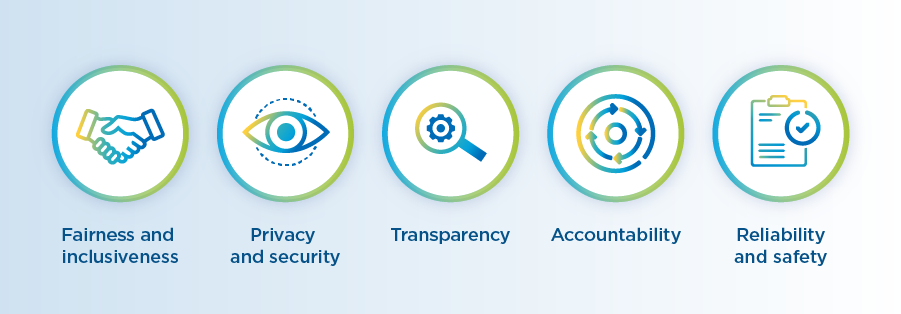Blog
Generative AI vs. Predictive AI
Contact Us
Labor and skills shortages plus an economic upheaval are leaving many organizations wondering, “What can I do to make my business more efficient while maintaining (or ideally improving) quality and customer/employee experience?” Many are turning to artificial intelligence (AI) to fill those gaps and aid in more effective decision-making processes.
With AI constantly creating new opportunities, it also raises questions about the ethics of the technology: fairness, equality, privacy, transparency, trust and control.
In this article, we’ll look at:
Responsible AI is about approaching the AI development process from an ethical and legal standpoint. The goal is to employ safe, trustworthy, transparent AI usage. This protects you by ensuring your organization stays compliant and follows all the applicable laws and regulations; it also ensures your organization maintains a good reputation. AI systems should treat people, security and the environment with the highest standards at all times.
Good AI is good for your business. That includes:
Intelligent automation (IA) combines robotic process automation (RPA), business process management (BPM) and AI to automate and streamline business processes. AI is a key factor in intelligent automation, which is why responsible AI is so imperative. How you’re training and adapting your IA initiative will directly affect your organization’s reputation and adherence to laws and regulations.
If you don’t take a responsible approach to leveraging AI, you may run into legal, financial and reputational penalties. The data sets you use to train your machine learning (ML) models can introduce bias into your AI system. This can be caused by faulty or incomplete data.
If aspects like data quality aren’t considered when training models, this can result in a biased AI program, which can poorly affect people and businesses. Irresponsible AI adoption runs the risk of:
Create more transparent AI systems to increase end-user trust and protect your people and organization from negative repercussions. Because at the end of the day, if you’re using technologies like AI correctly, you’ll have the confidence you need to scale and develop even better processes across your enterprise.
In the next section, we’ll show you some best practices and tools to help you implement responsible AI standards.
Beyond your general best practices for implementing any new software system into your business units, let’s look at some key approaches for ensuring AI ethics.
Before deploying AI into your real-world business practices, start with:
Before implementing emerging technologies such as generative AI, you should develop a strategic plan. Our 2022 survey of 850 senior executives globally revealed widespread recognition of the importance of responsible AI and AI regulation. But only 6 percent of organizations felt they had a fully robust, responsible AI foundation in place. (Accenture, “A new era of generative AI for everyone)
Here are our top tips for how to prepare for gen AI:

Now, let’s design responsible AI principles for your framework. Ongoing monitoring is critical to ensuring your AI stays ethical. Following a maturity model or operating model may help you design and implement a secure and reliable AI system.
At its foundation, you should build your AI around these five mandates:
An AI system should treat everyone fairly and without bias toward or against certain groups of people.
For example, when a healthcare provider uses AI to recommend a medical treatment based on a patient’s symptoms, AI should make the same recommendation for anyone with those symptoms regardless of their financial or professional standing.
AI decision-making systems risk unfair bias when based on historical human data and impact. You should ensure that after you’ve trained your ML models on existing data collected from the real world, you identify the problematic biases. These biases may be based on ethnicity, gender, religion, political leaning, culture, etc., and cannot go unnoticed in your AI’s learning.
In practice, these are the factors you should consider in your AI systems:
From business information to personal privacy, the data used by AI is becoming increasingly complex. Training data can be sensitive and, in some cases, important for your AI system (e.g., cancer detectors based on past patient scans).
Your AI system needs to comply with all laws and regulations applicable to your region and industry. But they should also consider social and individual expectations. Particularly, look at the transparency of:
To have an effective AI model, you need direct insights into how everything in your system runs. You should know exactly how your AI system makes a decision, called “explainable AI”. This helps you avoid mistakes or biases and also supports any scaling you’d like to do in the future.
For example, if a bank uses AI to decide if a person is eligible for a loan, the decision-makers should be able to go back through the data and see exactly how the system arrived at this choice, and whether any unexpected biases were present.
Transparency will show you:
The developers designing and deploying your AI system are accountable for any action or decision it makes. Establish an internal review body early on to give your systems and people the guidance and oversight they need to help your organization thrive. Draw upon industry standards to help you develop accountability norms and ensure your AI systems aren’t the final authority on any decision.
Look for an ML training model that enables you to:
Consistency is key to a reliable and safe AI system. It should perform as it was originally designed and also respond safely in new situations. How your systems behave and respond to unanticipated conditions depends on the range of conditions set during the design and testing phases.
For example, discrepancies may occur when your system underperforms for a certain demographic. That’s why rigorous testing and validation are imperative. Developers need to check how your AI system responds to edge cases within your operating conditions.
It’s also important to note that your AI system performance can degrade over time. Continuous monitoring and model tracking are essential to keep your AI’s performance reliable and safe.
In practice, your developers need to:

From the purpose of the system to how people interact with it, your AI adoption should have beneficial and equitable outcomes. To achieve those benefits, you need a robust, strategic AI framework.
With responsible AI practices, you can:
Overlooking AI ethics and best practices can result in financial and reputational damage for your organization. But with responsible AI, your organization can scale and evolve all of its operations.
Central to responsible AI are five core principles: fairness and inclusiveness, privacy and security, transparency, accountability, and reliability and safety. Upholding these principles requires clear ML and AI models, rigorous data validation, explainable AI systems, bias mitigation strategies, robust security measures, and continuous monitoring and validation.
Responsible AI isn’t just a moral imperative; it’s a strategic necessity for organizations navigating the complexities – and the benefits – of an AI system. As you embrace the transformative power of AI, do so with a commitment to responsible innovation, ensuring that technology serves as a force for good in our interconnected world.
Download our Gartner® report: A CTO’s Guide to the Generative AI Technology Landscape
If your network blocks YouTube, you may not be able to view the video on this page. In this case, please use another device. Pressing play on the video will set third-party YouTube cookies. Please read our Cookies Policy for more information.